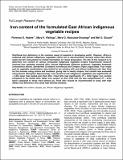Iron content of the formulated East African indigenous vegetable recipes

View/
Publication Date
2009-12-31Author
Florence O Habwe, Mary K Walingo, Mary O Abukutsa-Onyango, Mel O Oluoch
Metadata
Show full item recordAbstract/
Nutritional iron deficiency is the common cause of anaemia in developing world. However, Africa is endowed with African indigenous vegetables (AIVs) rich in micronutrients. Surveys within East Africa relate low AIV consumption to limited information on recipe preparation. The aim of this research is to determine iron content of various formulated indigenous vegetable recipes. Experimental research involved four randomly selected AIVs; African Nightshade (Solanum scabrum), Vegetable Amaranth (Amaranthus blitum), Slenderleaf (Crotalaria ochroleuca) and Cowpea (Vigna unguiculata). Four single and six vegetable combinations were boiled for ten minutes with and without traditional salt, then fried for five minutes using onions and tomatoes, giving rise to twenty recipes. Iron content was evaluated using Atomic Absorption Spectroscopy. Iron content of raw indigenous vegetables was significantly (P < 0.05) lower than boiled and fried AIVs. Fried AIVs had significantly (P < 0.05) higher iron content compared to the boiled AIVs. Mean iron content of AIVs fried with lye was insignificantly (P > 0.05) lower compared to those fried without lye. Fried AIVs should be recommended in areas with high dietary iron deficiency; this could help alleviate anaemia.
